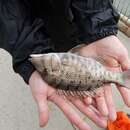en
names in breadcrumbs


Lethrinus laticaudis, the grass emperor, is a species of emperor native to the western Pacific Ocean where they occur on coral reefs at depths of from 5 to 35 metres (16 to 115 ft). Juveniles inhabit beds of sea grass and also in mangrove swamps. It can reach a length of 56 centimetres (22 in) TL though most do not exceed 35 centimetres (14 in). This species is commercially important and is also popular as a game fish.[2]
Grass emperors are browny-grey with darker brown blotches and streaks along their sides. They have olive cheeks covered with white speckles, their pectoral fins are tinged with blue, and all other fins are tinged with pink. They also have fine blue lines radiating from their eyes, with some crossing the snout.
Lethrinus laticaudis, the grass emperor, is a species of emperor native to the western Pacific Ocean where they occur on coral reefs at depths of from 5 to 35 metres (16 to 115 ft). Juveniles inhabit beds of sea grass and also in mangrove swamps. It can reach a length of 56 centimetres (22 in) TL though most do not exceed 35 centimetres (14 in). This species is commercially important and is also popular as a game fish.
Grass emperors are browny-grey with darker brown blotches and streaks along their sides. They have olive cheeks covered with white speckles, their pectoral fins are tinged with blue, and all other fins are tinged with pink. They also have fine blue lines radiating from their eyes, with some crossing the snout.